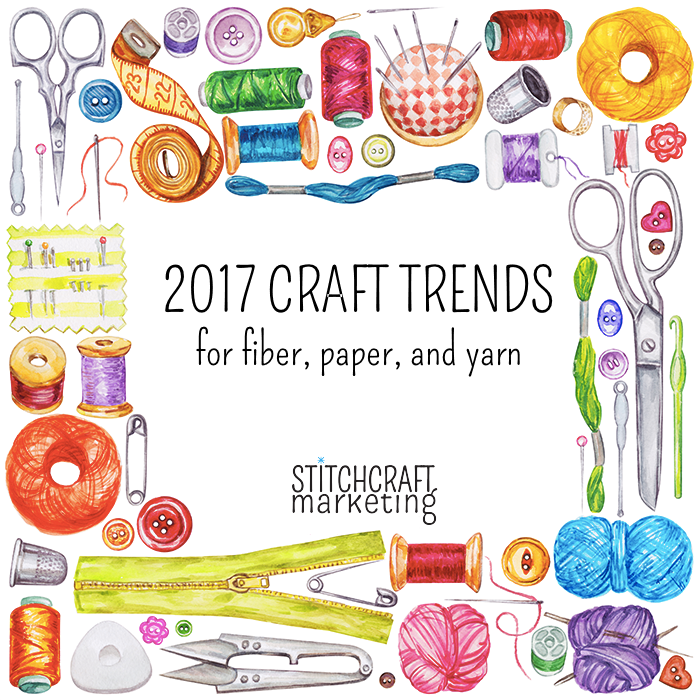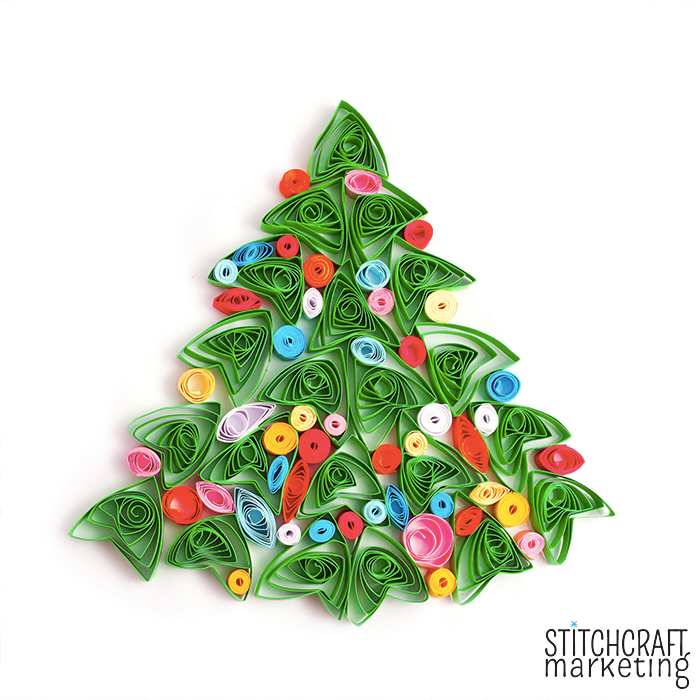28 Dec Crafting Trends for 2017 Part 2: Fiber, Paper and Yarn
 Our last post examined the trends we’re seeing in needle-arts crafting, both decorative and practical, as we move into 2017. In this post, we look at trends in the fiber crafts, including paper crafts.
Our last post examined the trends we’re seeing in needle-arts crafting, both decorative and practical, as we move into 2017. In this post, we look at trends in the fiber crafts, including paper crafts.
Yarn and Fiber Crafts
The extreme knitting and giant yarn projects are still with us, with videos making the rounds of Facebook on a regular basis. Fluffy garter-stitch and stockinette blankets either arm-knitted or knitted on needles the size of broomsticks are hot home decorating accessories. It’s about volume, speed and softness. Being able to recreate these designers looks by themselves are bringing a lot of non-knitters into yarn shops wondering how hard it could be. The challenge for the yarn manufacturer and local yarn store is to convert these novelty knitters into dedicated crafters.
One way might be to ease them into smaller needles and projects. “Small” being a relative term, of course. New knitters who come to the craft via arm-knitting and other forms of giant knitting are great candidates practical projects written at the super-bulky size (US needles 13-19). They have the motions of knitting down, so moving them toward knitting in the round with a hat or cowl, or introducing the concept of shaping with a super-bulky top-down raglan sweater teaches them to understand the architecture of knitting and gives them the skills they need to tackle projects at a smaller gauge. Early success is the best way to turn curiosity into a lifelong hobby. Consider partnering with a designer or an LYS to promote a Learn-to-Knit program at this super-bulky gauge.
In the world of knitting pattern design, we are seeing a couple of contradictory simultaneous trends. On the one hand, some popular designers are pushing the boundaries of technique and construction, creating garments that start neither the top nor the the bottom, but somewhere else entirely; on the other hand, you have the launch of the Mason-Dixon Knitting Field Guides, which are very much back-to-basics, bread-and-butter comfort knitting. In both trends, we are seeing pre-selected color combinations being sold as sets or kits with the pattern included. If you follow indie dyers on Instagram, you may be seeing a lot of posts with pairs, trios and quartets of colorways that play well together in multi-yarn patterns. There are still a lot of yarn hobbyists who want to make the pattern exactly as they’ve seen it. Choosing their own colors terrifies them, so offering suggested groupings can ease their fears.
One of the things we noticed at a couple of fiber festivals this fall was the translation of felted home decor items like this Felted Wool Pebble Rug into kits for crafters to make themselves. The assemblage of felted ball items, whether it is rugs, wreaths or hot trivets, is a trend we’re seeing both from fiber artists and interior decorators. It’s fun when those of us in the craft industry see our influence on commercial design trends. We’re ready to help people do it themselves.
Paper Crafting
Paper crafting seems to be expanding beyond stamping and collage and into intricate folding. Some of the most eye-catching and best-selling items at a recent craft guild show were origami ornaments folded out of printed papers reminiscent of calico fabric, or out of holiday metallics. The ornaments were large and 3-dimensional, recalling the shapes of traditional blown-glass ornaments. They were fresh and unique while still complementing a classic Christmas decorating scheme. Quilling, another papercraft in which thin strips are coiled into circles, spirals,or paisleys and joined together to make larger shapes, was also represented among the Christmas tree ornament crafters. The paper ornaments produced by both origami and quilling artists were accessibly priced as handmade goods.
In fact, dimensionality may be the best way to describe the trends we’re seeing in paper. Whether it’s elaborate pop-up cards, handmade (folded) gift boxes or ornaments, papercrafting isn’t only flat anymore. Like the intersectionality and cross-crafting we noted in Part 1, we are getting a perception that there is interest in pushing beyond the traditional limits of any particular craft medium. Exploring exactly what paper, yarn and fabric can and cannot do is something we’re seeing wherever we’re looking at craft.

Crafts and Coloring
Finally, we have to note the intersection of the adult coloring book trend with the crafting world. Since so much of what creates pleasure in traditional textile, fiber and beading crafts is the choice and placement of color and pattern, this development is hardly surprising. Many crafters have always doodled with pencils, crayons and markers to figure out color combinations for a Fair Isle pattern, a quilt top or a loom warp. That activity is now formalized and published as coloring books for different segments of interests. There are knitting-themed coloring books, quilting-themed coloring books, coloring cookbooks, coloring books for birders. Coloring isn’t going away and catering to the interests of specific niches is one of the ways in which it is staying fresh. The materials and supplies for avid colorists are going to continue to be in demand.
Let us know in the comments what other trends you’re seeing in the craft world. We are always interested in hearing from our clients and readers about their experiences.
If you’re looking for more ideas to help you expand your craft-based business, contact us. We make magic for your brand.


No Comments